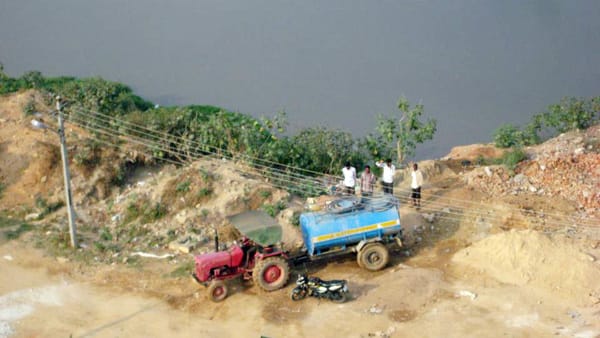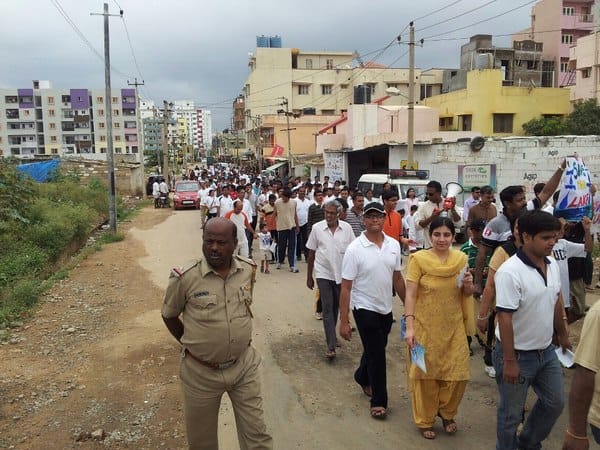Even after repeated appeals, protest marches and follow-up, there has been no let-up in encroachment of the Haralakunte or Somasundarapalya Lake in HSR Layout. Various groups have been dumping debris into the lake with impunity for long and of late, tankers have taken to pumping out whatever water is left. As residents of the area we feel that given the trend, it may not be long before Bangalore loses yet another of its precious water bodies.
The most sustainable solution to water woes of any community could come through its water bodies. Not every locality in Bangalore has one; we were lucky to have one but failed to recognise its importance. In the absence of appreciation of its need, encroachers took it to their advantage. (There is a rumor that a new layout or apartment complex is coming up there!)

For the past 3 days, the same tractor is pumping the water out of the lake. Pic: SaveOurSomasundarapalya FB page.
Somasundara Palya Lake or Haralukunte Kere is situated at the end of 24th Main Road in HSR Layout (Mangammana Palya ward). A lake that spanned 16 acres and 29 guntas not so long ago has completely lost 2 acres and 9 guntas to encroachment, and shrinks some more everyday.
Overall, the encroached lake bed seems to have become a hot-bed of settlement and construction activity, with shanties, temples and other structures happily lodged. A new road has come up on one side and gets progressively widened as more mud is dumped on to the lake almost every other day. The number of apartment complexes in the immediate vicinity has been rising continually and sewage from these seeps into the lake, polluting it further.
Residents of Somasundara Palya and nearby areas have been urging authorities to take steps against the destruction of the lake for close to a year now. A group of us fighting for this cause met the BDA Engineer in charge of lakes in South Bangalore in 2012. We were promised security for the lake but months on, no guards have yet been posted.
The police was instructed to seize any vehicles attempting encroachment or pollution but in the absence of round the clock monitoring – since most of the dumping takes place at night, when the neighbourhood sleeps – such orders have proved toothless. The BDA had also asked the Tehsildar to take steps towards clearing the encroachment and fence off the area to prevent further damage, but that never happened either.
Disappointed by the inaction and false promises of the authorities, residents of the neighbourhood took out a ‘walkathon‘ in early October, 2012, in which more than 500 residents took part, demanding the restoration of the lake. Hari Shilpa – the Tahsildar at that time – met the residents at the site and assured action to help resolve the issue, as did local MLA Sathish Reddy. However, there has been no visible action on this to date and the lake continues to be exploited.

Walkathon by residents around lake. Pic: SaveOurSomasundarapalya FB page.
We have made several subsequent efforts to follow up with the Tahsildar’s office but they have proved futile. We were told that since the land belongs to the government, only the BDA has the power to initiate action on these complaints. Phone calls to the BDA Engineer often go unanswered.
Desperate to save this ecological resource, we have now approached the Bangalore Metropolitan Task Force with our complaints. An email response from the BMTF tells us: "Your complaint was transferred to Tahsildar South for taking necessary action. The Tahsildar South has reported us that he will take action as per KLR Act 1964, Section: 94."
Citizens interested to follow developments in the Somasundara Palya lake encroachment case can follow: Save Our Somasundarapalya Lake Facebook page
If you want to support the cause, visit:
change.org petition to complete lake survey and clear encroachments
However, given the history of past interactions with the Tahsildar’s office and the outcomes that followed, such response inspires little hope. We are unable to understand what stops the government from taking steps to contain the encroachment. Are they under someone’s spell? Do the interests of citizens mean nothing to the government?
Ground water level is getting depleted across Bangalore – there is water shortage everywhere.. what is the solution the government plans to provide ? The least it can do is try and save the lakes but it is only losing them all to real-estate & tanker mafias.
We seek the cooperation of all authorities and support from citizens to protect our lakes.
⊕